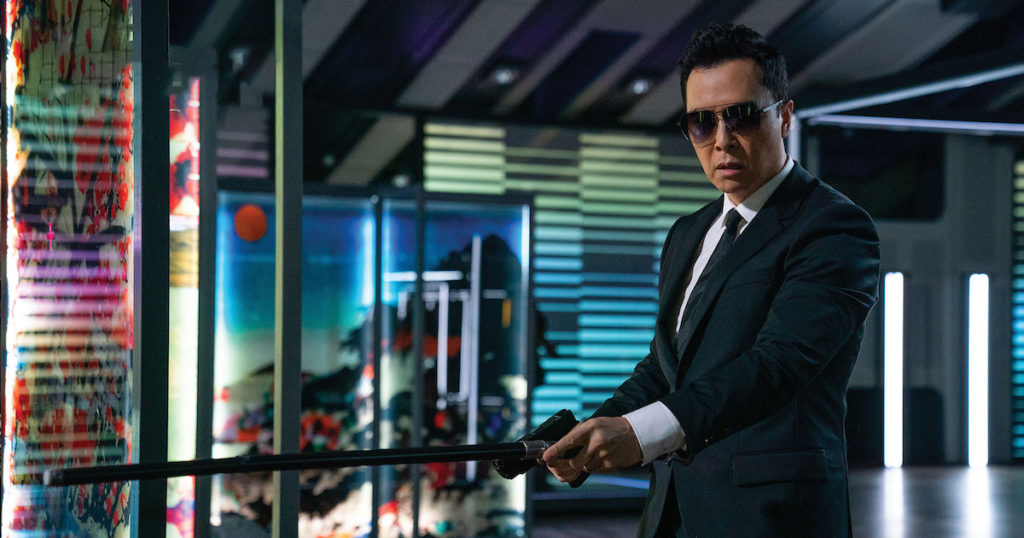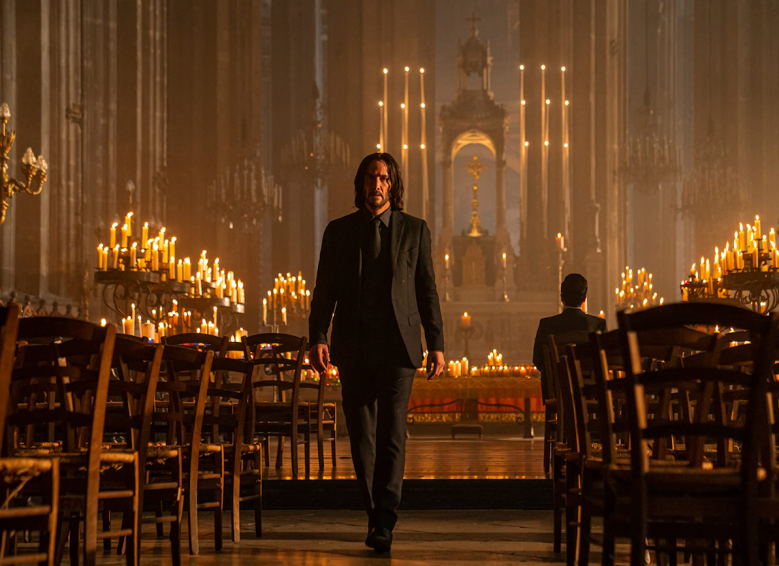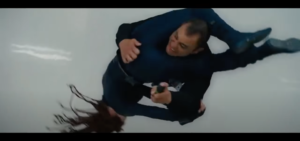
“Off the floor, on the board.” Those were the words of announcer Gary Thorne during Game 6 of the 2003 Stanley Cup Final. Halfway through the second period, lifelong thug and New Jersey Devils forward Scott Stevens almost killed the Anaheim Ducks’ Paul Kariya in open ice before 17,174 spectators. A late hit and arguably a charge (also a penalty), Stevens makes direct and primary contact with Kariya’s head: you don’t have to know hockey to understand that’s not cool. He laid cold on the ice, in a moment that would likely now call for an emergency stretcher. There’s a good argument Stevens should have been legally charged with assault.
But, as any fan of hockey knows, Kariya returns to the game just minutes later and scores, sealing the Game 6 victory.
That 2003 Cup Final has a lot in common with the filmmaking of Chad Stahleski and Keanu Reeves in John Wick: Chapter 4. The horrifying spectacle of the hit, the ability of Kariya to completely body the ugly head contact—including the dubious medical ethics that enabled Kariya’s return—and the good-guy triumphs over the big-bad ending is basically the modus operandi of the Wick franchise, especially in the latest John Wick: Chapter 4. To extend my metaphor, in this case Stahleski and Reeves all but ask the viewer to appreciate not only Kariya’s perseverance and skill but also Stevens’s physicality and power.
Following his excommunication, John Wick (Reeves) enacts a revenge tour on the senior members of the High Table and requires shelter from his few remaining friends, Shimazu Koji (Hiroyuki Sanada) in Osaka, the Bowery King (Laurence Fishburne) in New York, and the Belarusian Ruska Roma in Berlin as the Marquis Vincent de Gramont (Bill Skarsgård) seeks to eliminate the ideology of Wick—whatever that is, I do not know. The two most noteworthy new characters rise to different levels of success. A man with a dog, known as Mr. Nobody (Shamier Anderson), follows Wick around as he waits for the bounty to rise…though he’s ultimately a superfluous bug in an overpacked story. Unless there’s some unwritten rule that these films need a dog, all the character does is distract from the film’s more serious and focused threads… like John Wick killing a bunch of people with a variety of weapons and looking cool doing it.

The other important new face, Donnie Yen as the blind assassin Caine, dazzles as usual. Yen is one of the world’s great hand-to-hand movie fighters and stunt persons, and he clearly still has it as he approaches his 60s; it’s probably his best action since Ip Man 4: The Finale (2019). Of course, I’m not sure how much is actually him and how much are his doubles, but, regardless, he provides the action with the gravitas of a man who has starred in several of the greatest action films of the 21st century. He’s more than the grizzled vet—and he’s probably the series’ only true equal to Wick, which makes sense because it would just look wrong to see Yen lose to Reeves. It’s safe to say the majority of my audience likely had no idea who he was (or recognized him only from Rogue One) and they still reacted as if he were the Jersey Devil himself. Yen is a perfect fit for the role, and Caine is the best antagonist in the four Wick films.
At some point, the original premise of the franchise– “if the worst man in existence found salvation”– runs its course and the saved becomes damned again. The killing spree by Reeves’ Wick virtually loses any sense of purpose, reducing the violence to pure red-eyed manic. In this sense, John Wick has become Scott Stevens.
Starting with a murder tour of the High Table somewhere in the desert of Morocco that appears purposeless, he’s a goon for the majority of the runtime, and as the films go on, the excuses become less and less believable. That’s not to say John Wick: Chapter 4 is a bad film. I don’t think it is. But it’s still morally compromised in a way that even the first film wasn’t. Nobody comes to the John Wick franchise for ethical formation, but, at a certain point, his inability to stop murdering—and for individualistic reasons rather than the social good, I might add—makes it increasingly difficult to continuously side with the character.
In one of Wick’s more sympathetic (and Kariya-like) moments, he must fight his way to the top of an extremely long set of stairs before the metaphorical ticking clock runs out. It’s a simple set-up with Paul W.S. Anderson-level geographical genius behind it: there’s a linear and easily understood geography that cannot be transgressed but must be confronted. This physical confrontation with geography fosters the emotional response. Close to triumph (communicated only through Wick’s physical position near the top of the stairs), he winds up painfully tumbling down to the concrete base of the stairs. He must (literally) “get off the floor” and (metaphorically) “on the board” before his time runs out. I’ll be damned if it isn’t the best single scene in the four Wick films.

It’s not just Wick, though. Characters all around seem capable of powering through more blows than in the previous entries. I suppose this is in part excused by the increased prominence of the kevlar dress suits of basically all of the characters, but it’s also a side-effect of the series’ exponential mythologization that reached annoying heights in Parabellum. Assassins quote Dante’s Divine Comedy and Ecclesiastes and give grand speeches before gorgeous and recognizable compositions in the Louvre…but it only really works if you don’t think about it too hard.
Most disappointingly, John Wick: Chapter 4 probably showcases the weakest action in the series. I’m not sure if they’ve just run out of creative ways to kill (the hallmark of the Baba Yaga), if Reeves is getting too old, or if the gun-fu has just lost its zest. There are really only two action scenes that meet the standards set by the first film: the staircase climax and the ten-minute nunchuck onslaught in Osaka. The rest, competently shot and excellent by the standards of the rest of the industry, lacks the creativity of the pencil kills and knife throwing of the first three films.
One positive movement in the series’s choreography is the male use of the “leg thing,” as my wife calls it. Something she first noticed in the action of the MCU, Black Widow (Scarlett Johansson) and most other fighting women in Marvel movies, consistently use one move that men rarely replicate: the leg wrap around the opponent’s neck for the takedown. It de-grounds the women, making them appear “weaker”—men, by contrast, are always grounded, unable to lose control of their physical situation. The women (or those using the “leg thing”) have to leave the ground in nearly every choreographed fight scene, losing said control. It’s also brazenly and damningly sexual. The female genital area so near the opponent’s face, who is usually male, already breaches into the realm of sexual power plays. The legs that do the actual takedown also tend to be sexualized.
That Wick uses variations on the move at least twice—completely leaving the ground and taking down his opponents with his legs near their heads—is noteworthy in itself. In American cinema, it’s not even that common for male action stars to use their legs in a fight scene. The likes of Arnold Schwarzenegger, Sylvester Stallone, and Bruce Willis weren’t exactly the most agile of actors. Tom Cruise and Chris Evans both occasionally kick on occasion, but I’m not sure I could imagine either of them doing something like the stunt work Marvel’s women are subjected to. Wick is a de-grounded character, never really in control of anything, and always one step behind. In this sense, it’s fitting that Reeves’ Wick would provide one of the notable masculine uses of the takedown. Unsurprisingly, and how these things tend to go when men are involved, the takedown is thoroughly de-sexualized.
John Wick: Chapter 4
2023
dir. Chad Stahleski
169 min.
Opens in theaters everywhere Friday, 3/24


